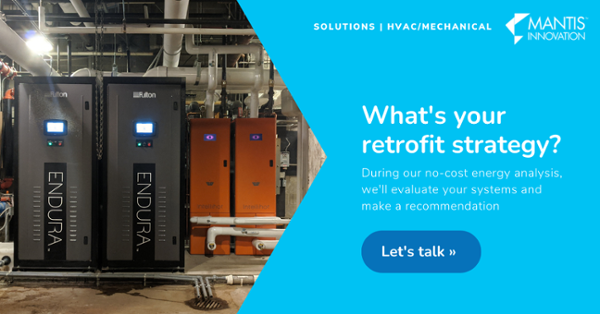Energy Efficiency | April 20, 2020
4 Energy Efficiency Tools for Building Management During COVID-19
The COVID-19 crisis has the majority of Americans working from home in numbers never seen before. The crisis is impacting organizations differently by industry. Many of the buildings where employees work are now standing empty (or near empty) while others, such as hospitals, are running at about 110% capacity. Neither were designed for these situations. But there is hope as it relates to energy efficiency.
I have worked through a few historical times in our country’s history: The Gulf War, September 11th, and the more recent market collapse in 2008. Similar to those situations, COVID-19 is quite unique.
I am being asked by my customers:
“What can I do to reduce costs during this time?”
Prior to COVID-19, the question was usually part of longer-term strategic planning. But for the past 6 weeks, I am asked the question with more of a sense of urgency.
Now, when asked, the question is ‘how quickly’ can programs be implemented. In many of these instances, the dollars saved are translated into how many jobs this will save, including sometimes, their own.
Although building management has changed during the COVID-19 outbreak, there are several energy efficiency tools that can be leveraged to improve operations throughout the duration of the virus.
Efficiency solutions do more than just save energy. While energy savings is the backbone of efficiency upgrades, other benefits such as lowering operational costs, improving working environments (lighting, heating/cooling) and enabling remote access – are all part of well-designed efficiency services.
At this unique point in our lives, these benefits are necessary now, more than ever before.
Listed below are four tools you may be able to implement for COVID-19 energy efficiency strategies in a quick time frame to improve efficiency and reduce unnecessary costs. These savings, which typically average 35% efficiency, in some cases can now improve to over 50% off your utility cost if your building is closed or limiting operations due to COVID-19.
Four efficiency tools to enable better building management during the coronavirus
1. Remote monitoring Building Management Systems
Remote monitoring Building Management Systems (BMS) means having the ability to view building systems information and adjust set-points while working remotely. Accessing buildings while off site has never been more important. This prevents employees from having to go into the office to manage the organization’s facilities.
Many buildings are standing empty or running unusual hours compared to normal. Using remote monitoring tools to manage your building automation allows facilities staff to have a clear picture of a building’s operations without having to step a foot on campus.
 Example BMS dashboard
Example BMS dashboard
2. LED lighting occupancy sensors
Occupancy sensors are a basic component of LED lighting fixtures and turn the lights on and off when sensing movement to save energy. However, they also mean lighting can remain completely off for as long as necessary if no movement is sensed. Many of our customers have also used the motion sensors as a security measure, especially in unoccupied buildings.
Lighting controls have grown in importance over the last decade and where occupancy sensors may have once been a luxury, they’re a standard option for many efficiency installations because of the benefits they bring to a building environment.
3. Fully networked LED lighting solutions
You can do more with your lighting than you may even realize. Networked LED lighting is a lighting system that’s been designed for efficiency, tied into a larger controls network and includes program access to:
- Manage light levels
- Turn lighting on/off
- Group fixtures
- Adjust settings remotely.
Similar to remote access building management systems, these controls systems are designed specifically to handle a building’s – or entire campus’ – lighting configuration.
4. Demand control ventilation
Demand control ventilation (DCV) is the process of establishing setback points for HVAC equipment and adjusting air ventilation based on a building’s occupancy in order to automatically reduce outdoor air intake. Controlling the ventilation can include air changes per hour and space temperature.
Demand control ventilation can significantly reduce energy used by HVAC systems to power empty building environments. Remote monitoring through building automation can allow facilities staff to make these adjustments without being physically on site.
Efficiency solutions = operational improvements
Saving energy is an obvious benefit to COVID-19 energy efficiency measures. But the operational improvements available through turnkey solutions should also give you greater control over many types of building environments: including everything from overtaxed systems to completely empty facilities.
Lowering strain on equipment and controlling systems remotely are two of the main advantages these efficiency tools can offer operations teams during the COVID-19 outbreak.
Our best wishes to you during the coming weeks and months as we all work together to keep our systems running and defeat the virus.
Related Posts
Discover more content and insights from Mantis Innovation

The Cost of Inaction: Why Businesses Should Act Now on Energy Efficiency
In today's fast-paced business environment, the financial and operational losses businesses incur by delaying energy efficiency improvements, the "cost of inaction," is more relevant than ever.

In today’s AI era, human intelligence is the key to data center facility and energy optimization
Nowhere else in modern industry do artificial and human intelligence converge with such transformative potential as in the world of data centers. As AI's extraordinary growth accelerates demand for

Your Guide to LED Lighting for Business and Commercial Buildings
Never to be underestimated, LED lighting and well-designed lighting retrofits and upgrades offer businesses big improvements like reduced energy costs, reduced emissions, and improved working

Five Trends Driving Data Center Facility Energy Optimization
Today’s digital economy, commercial and industrial digitalization, and the recent explosion in artificial intelligence and machine learning (AI/ML) powered computing are driving massive growth in
